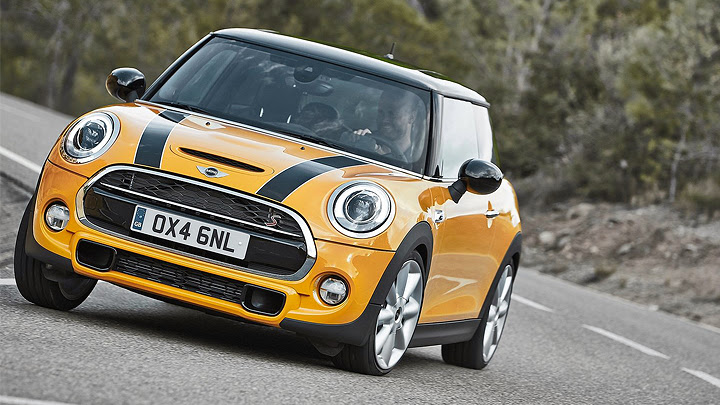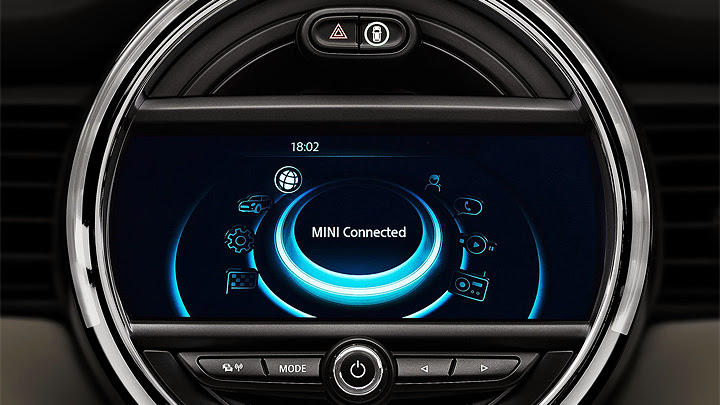
Like the pictures show, Cooper really didn’t even try to change because it would be actually wrong for its case. The automaker’s fans like it just as it looks, so what BMW (who owns Mini) does are slight proportion changes just to make easier for people to notice there is a new car. However, the all-new platform made this Mini bigger than ever: since there are extra 98 mm at the length, 44 mm at the width and 7 mm at the height, you can use this official picture to compare all the Minis. The first impression is that the new vehicle got “bulkier” as a disguise for its increased dimensions, in order to maintain the overall proportions as untouched as possible.
Basically, it’s like if there was added yeast to the previous car. The sheetmetal took a bigger portion of the total height, while the floating roof became smaller. The front grille takes its hexagonal shape from both the first two Minis, but combines it to headlights as enlarged as the tail lights, which will certainly draw more attentions than ever. But it’s interesting to observe Mini could escape from the recent need of compensating the car’s growth with bigger wheels in order to keep looking well-proportioned: there are only black lines going under the doors and above the wheels to make the car look shorter and a little higher. It was possible to stay at 15-inch wheels without them looking too small.








The interior will reveal much deeper changes, but once again more at function than at form. Besides all the high-quality materials from which it’ll be possible to choose, for the first time ever Cooper’s instrument cluster left the circular central display, going to the conventional behind-the-wheel position. Such strategy made the driving information easier for the driver to read, while the other occupants can now enjoy a huge touchscreen dedicated to the infotainment system – there’s even a LED arch at the upper half of the circle, which turns on in different colors according to the need. Another interesting detail is the available head-up display, which takes that driving information right into the driver’s eyeline like what’s already seen in several luxury cars.
Besides, the dimension increase helped to make more room compared to the previous generation. Cooper still stays very far from being a family car, but it’ll certainly receive its four passengers much better. The front ones, specially, because the rear section is still much more suitable for children. The new platform is also expected to bring driving improvements, since it’s a whole new structure which is also intended to underpin some upcoming BMW cars with front-wheel-drive. The advantages taken by Cooper include keeping the previous weight, despite the bigger size, and receiving several mechanical upgrades like adaptive dampers, which will turn its sporty versions even more appealing.








Speaking of which, the remaining variations of the hatchback are expected to appear with the lineup’s showroom arrival, planned to happen next March. Meanwhile, Cooper features all-new three-cylinder 1.5L engines for both gasoline and diesel, as well as being made entirely of aluminum and equipped with turbocharger, direct injection and start/stop system. These are responsible of moving standard and D versions, with respective 136 and 114 hp; they’re respectively capable of 26.6 kpl/105 g/km and 34.3 kpl/92 g/km. Cooper S, in turn, shows its dedication to the performance with a four-cylinder, turbocharged 2.0L, which reaches 192 hp, 23 kpl and 122 g/km.
These engines will always have six-speed transmissions, whether manual or automatic – the last one has a sporty version which includes paddleshifters. The gasoline 1.5L goes from 0 to 100 kpl in 7s9 and the 2.0L in 6s9, but it’s interesting to notice that the self-shifter gearbox makes them actually faster, by 0s1 for both. The D version can also use both equipments, but these numbers weren’t available for it so far. The all-new Mini Cooper will hit the streets in a few months, of course starting with United Kingdom. The standard version will start at £15,300 there, while £16,540 will be charged for the diesel sibling and £18,650 for the S variation.
Lançamento no Brasil (03/06/2014)
Embora o visual nunca mude demais, a nova geração do compacto inglês evoluiu por completo. A quarta geração do Mini Cooper ganhou plataforma nova, e com isso ganhou em espaço, qualidade de construção, conforto e performance, entre outros aspectos. Quanto ao último, os destaques estão nos motores: o 1.5 turbinado de três cilindros gera 136 cv, e equipa sua versão de entrada, por R$ 89.950. Já o quatro-cilindros 2.0 turbinado gera 192 cv, e compartilha com o anterior o câmbio automático de seis marchas. Com este motor, o Cooper S custa R$ 107.950 e o Cooper S Top R$ 124.950. No segundo semestre a base da linha ficará com a One, com câmbio manual de seis marchas e 1.2 tricilíndrico de 102 cv.
Mini Cooper One (06/03/2015)
Assim como na geração anterior, esta é a versão de entrada do hatchback inglês. Sua mais nova geração se oferece no país por R$ 79.950, mas é importada em lotes muito limitados. Sua lista de itens inclui alarme, ar-condicionado de duas zonas, rodas de liga leve aro 15”, e sistema de áudio com Bluetooth. Quanto ao trem-de-força, ele recebeu um 1.2 turbo de três cilindros sempre associado a câmbio manual de seis marchas. De acordo com o fabricante, ele acelera de 0 a 100 km/h em 10,2 segundos e chega à máxima de 195 km/h. O Cooper One já se encontra disponível nas concessionárias brasileiras da Mini.